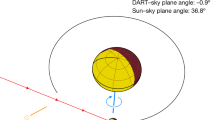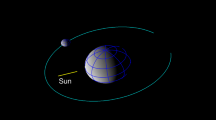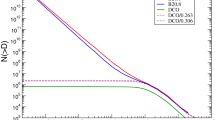Abstract
Encouraging diversity in planetary science requires making a particular effort to bring a broader range of people onto the mission teams that are the backbone of the field. Observer programmes, which offer early-career researchers the chance to embed within a mission team during a science meeting, are one way of doing this. Here we present a quantitative analysis of the effectiveness of two observer programmes: InSightSeers and DART Boarders, linked respectively to the InSight and the Double Asteroid Redirection Test (DART) missions, using a mixture of one-group pre-test/post-test and one-group post-test only evaluation methods, with a total of 56 participants. We find substantial educational value added to participants from both programmes, with particular strengths being the effectiveness of these programmes at providing an introduction to mission teams and international collaborations. This work demonstrates that mission observer programmes can be an effective way of exposing early-career researchers to planetary science missions.
This is a preview of subscription content, access via your institution
Access options
Access Nature and 54 other Nature Portfolio journals
Get Nature+, our best-value online-access subscription
$32.99 / 30 days
cancel any time
Subscribe to this journal
Receive 12 digital issues and online access to articles
$119.00 per year
only $9.92 per issue
Buy this article
- Purchase on SpringerLink
- Instant access to full article PDF
Prices may be subject to local taxes which are calculated during checkout




Similar content being viewed by others
Data availability
An exemplar application questionnaire, the various surveys used and raw data are available in Supplementary Information and Supplementary Data 1. Raw data have only been edited insofar as to remove personally identifiable information in one location, or to clarify named references to InSightSeers organizer team members in one place. Where this has been done, it has been clearly marked as such.
A copy of the participant agreement to take part in the survey, including approval and consent to publish results from our surveys, is included in Supplementary Information.
References
Rathbun, J. A. et al. Who is missing in planetary science?: Strategic recommendations to improve the diversity of the field. Bull. Am. Astron. Soc. 53, 435 (2021).
Rivera-Valentin, E. et al. Who is missing in planetary science?: Demographic study of the planetary science workforce. Bull. Am. Astron. Soc. 53, 443 (2021).
Zellner, N., Rathbun, J., Martindale, N. & Seidel, A. Participation of women in the annual Lunar and Planetary Science Conferences. Earth Space Sci. 9, e2021EA002188 (2022).
Rathbun, J. Participation of women in spacecraft science teams. Nat. Astron. 1, 0148 (2017).
Porter, A. M., White, S. & Dollison, J. 2020 Survey of the Planetary Science Workforce (AIP, AAS Division for Planetary Sciences, 2020).
Mandt, K. E. Increasing diversity on spacecraft mission teams reduces risk. Science 382, eadk7373 (2023).
Fernando, B. et al. Inclusion of early-career researchers in space missions. Nat. Astron. 6, 1339–1341 (2022).
Izquierdo, K., Du, J., Mukherjee, S. & Chavas, D. Increasing diversity in planetary science through the inclusion and retention of international graduate students. Bull. Am. Astron. Soc. 55, 2023n8i320p02 (2023) .
Schmidt, B. et al. Diversity in action: solutions for a more diverse and inclusive decade of planetary science and astrobiology. Bull. Am. Astron. Soc. 53, 426 (2021).
Fernando, B. et al. Strategies for making geoscience PhD recruitment more equitable. Nat. Geosci. 16, 658–660 (2023).
Curry, S. MAVEN mission perspectives and approaches to inclusion. Front. Astron. Space Sci. 10, 1162107 (2023).
Daubar, I. J. et al. InSightSeers: early career opportunity to observe the InSight Science Team at work. In Proc. 53rd Lunar and Planetary Science Conference (Universities Space Research Association, 2022).
Rivkin, A. & Chabot, N. The ‘DART Boarders’ program of the Double Asteroid Redirection Test (DART) mission. In Proc. Advancing IDEA in Planetary Science (Universities Space Research Association, 2022).
Smith, D. et al. Here to Observe (H2O): opening doors to NASA Planetary Science Division (PSD) missions and mentors for undergraduates from underrepresented institutions. In Proc. 54th Lunar and Planetary Science Conference (Universities Space Research Association, 2023).
Morris, J. R. et al. InSightSeers: peering into invited student participation of a mission science team meeting. In Proc. 54th Lunar and Planetary Science Conference (Universities Space Research Association, 2023).
Campbell, D. T. & Stanley, J. C. Experimental and Quasi-Experimental Designs for Research (Houghton Mifflin, 1963).
George, M. Teaching focus group interviewing: benefits and challenges. Teach. Sociol. 41, 257–270 (2013).
Tesch, A. Implementing pre–post test designs in higher education evaluations. New Dir. Eval. 2016, 85–96 (2016).
Behar-Horenstein, L. S. & Niu, L. Teaching critical thinking skills in higher education: a review of the literature. J. Coll. Teach. Learn. 8, 25–41 (2011).
Fearon, J. D. Ethnic and cultural diversity by country. J. Econ. Growth 8, 195–222 (2003).
Settling In 2018: Indicators of Immigrant Integration (OECD, 2018).
Cervulle, M. The uses of universalism. ‘Diversity statistics’ and the race issue in contemporary France. Eur. J. Cult. Stud. 17, 118–133 (2014).
Simon, P. in Social Statistics and Ethnic Diversity: Cross-National Perspectives in Classifications and Identity Politics (eds Simon, P. et al.) 65–87 (Springer, 2015).
Acknowledgements
The InSightSeers and DART Boarders programmes acknowledge the work of the Europa Clipper team in developing the original mission observer model. The InSightSeers programme was funded in part by the Jet Propulsion Laboratory at the California Institute of Technology under the NASA InSight mission. JPL provided travel support for InSightSeers’ travel and the organizer time needed to undertake this analysis. Additional organizer support was provided by the UK Space Agency under the Space for All programme. The DART Boarders programme was run by the Johns Hopkins Applied Physics Laboratory under the NASA DART mission. A portion of B.F.’s time was funded by JPL’s InSight closeout funding and the UK Space Agency’s Space for All scheme through Imperial College London. The remainder was funded by the Blaustein Fellowship at Johns Hopkins University. I.J.D. was supported by NASA InSight Participating Scientist grant 80NSSC20K0971. J.C.E.I. was supported by UKSA grants ST/W002515/1 and ST/W002523/1.
Author information
Authors and Affiliations
Contributions
B.F., I.J.D., C.N. and M.P.P. led the organization of InSightSeers. N.L.C. and A.S.R. led the organization of DART Boarders. All other authors assisted in the organization of InSightSeers and the securing of funding.
Corresponding author
Ethics declarations
Competing interests
The authors declare no competing interests.
Peer review
Peer review information
Nature Astronomy thanks Natasha Dowey and the other, anonymous, reviewer(s) for their contribution to the peer review of this work.
Additional information
Publisher’s note Springer Nature remains neutral with regard to jurisdictional claims in published maps and institutional affiliations.
Supplementary information
Supplementary Information
InSightSeers programme application form, pre- and post-programme evaluation questionnaires and participant agreement.
Supplementary Data 1
Responses to the survey questionnaires.
Rights and permissions
Springer Nature or its licensor (e.g. a society or other partner) holds exclusive rights to this article under a publishing agreement with the author(s) or other rightsholder(s); author self-archiving of the accepted manuscript version of this article is solely governed by the terms of such publishing agreement and applicable law.
About this article
Cite this article
Fernando, B., Newman, C., Daubar, I.J. et al. Evaluation of the InSightSeers and DART Boarders mission observer programmes. Nat Astron 8, 1521–1528 (2024). https://doi.org/10.1038/s41550-024-02434-1
Received:
Accepted:
Published:
Issue date:
DOI: https://doi.org/10.1038/s41550-024-02434-1



